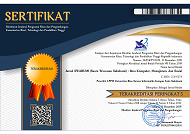Dampak Green Supply Chain dan Green Product Melalui Green Consumer terhadap Pembelian Kopi
Abstract
Permasalahan utama yang dihadapi pelaku UMKM kopi di Kota Sukabumi adalah rendahnya pemahaman konsumen terhadap praktik keberlanjutan, baik dalam rantai pasok maupun atribut produk, yang berpotensi memengaruhi keputusan pembelian. Penelitian ini bertujuan untuk menganalisis pengaruh Green Supply Chain Management (GSCM) dan Green Product Features (GPF) terhadap Green Consumer (GC) serta implikasinya terhadap Keputusan Pembelian (KP) konsumen. Metode yang digunakan adalah pendekatan kuantitatif dengan teknik Structural Equation Modeling–Partial Least Squares (SEM-PLS), melibatkan 118 responden konsumen kedai kopi. Instrumen penelitian diuji validitas dan reliabilitasnya, dilanjutkan dengan pengujian outer model, inner model serta efek mediasi melalui bootstrapping. Seluruh proses analisis data, termasuk pengolahan statistik, visualisasi grafik dan penyusunan tabel, didukung dengan bantuan teknologi kecerdasan buatan melalui ChatGPT sebagai alat bantu penelitian. Hasil penelitian menunjukkan bahwa GSCM dan GPF berpengaruh signifikan terhadap GC, sedangkan GC berpengaruh signifikan terhadap KP. Analisis indirect effect menegaskan bahwa GC berperan sebagai mediator penuh dalam menjembatani pengaruh GSCM dan GPF terhadap KP. Temuan ini memperlihatkan pentingnya kepedulian lingkungan konsumen sebagai determinan utama dalam keputusan pembelian berkelanjutan. Penelitian ini menyimpulkan bahwa strategi rantai pasok hijau dan atribut produk ramah lingkungan dapat memperkuat preferensi konsumen terhadap produk kopi berkelanjutan, serta membuka peluang bagi UMKM untuk mengembangkan strategi pemasaran hijau yang lebih efektif.
Full Text:
PDF (Bahasa Indonesia)References
Abdul Aziz, U., & Saggaf Shihab, M. (2024). Penerapan Green Marketing dan Dampaknya Terhadap Citra Perusahaan. Journal of Economics and Business UBS, 13(2), 492–502. https://doi.org/10.52644/joeb.v13i2.1560
AICE. (2025). Data Konsumsi Kopi Harian Rata-Rata di Indonesia. Aeki-Aice.Org. https://www.aeki-aice.org/data-konsumsi-kopi-harian-indonesia/
Alkandi, I., Alhajri, N., & Alnajim, A. (2025). Green Supply Chain Management, Business Performance, and Future Challenges: Evidence from Emerging Industrial Sector. Sustainability, 17(1). https://doi.org/10.3390/su17010029
Arli, D., Tan, L. P., Tjiptono, F., & Yang, L. (2018). Exploring consumers’ purchase intention towards green products in an emerging market: The role of consumers’ perceived readiness. International Journal of Consumer Studies, 42(4), 389–401. https://doi.org/https://doi.org/10.1111/ijcs.12432
Augtiah, I., Ihwan Susila, & Wiyadi. (2022). Pengaruh Green Product, Green Advertising, Dan Green Brand Image Terhadap Keputusan Pembelian Dengan Consumer Attitude Sebagai Variabel Mediasi. Benefit: Jurnal Manajemen Dan Bisnis, 7(2), 10–26. https://doi.org/10.23917/benefit.v7i2.1486
Barbu, A., Catană, Ștefan A., Deselnicu, D. C., Cioca, L. I., & Ioanid, A. (2022). Factors Influencing Consumer Behavior toward Green Products: A Systematic Literature Review. International Journal of Environmental Research and Public Health, 19(24). https://doi.org/10.3390/ijerph192416568
Chen, Y. (2011). Green organizational identity: sources and consequence. Management Decision, 49(3), 384–404. https://doi.org/10.1108/00251741111120761
Cochran, W. G. (1977). Sampling techniques. Johan Wiley & Sons Inc.
Creswell, J. W., & Creswell, J. D. (2017). Research design: Qualitative, quantitative, and mixed methods approaches. Sage publications.
Dillman, D. A., Smyth, J. D., & Christian, L. M. (2014). Internet, Phone, Mail and Mixed-Mode Surveys: The Tailored Design Method. John Wiley and Sons.
Dragolea, L. L., Butnaru, G. I., Kot, S., Zamfir, C. G., Nuţă, A. C., Nuţă, F. M., Cristea, D. S., & Ştefănică, M. (2023). Determining factors in shaping the sustainable behavior of the generation Z consumer. Frontiers in Environmental Science, 11(January), 1–21. https://doi.org/10.3389/fenvs.2023.1096183
Esmaelnezhad, D., Mohammad Dana, L., Antucheviciene, J., Hashemi, S. S., & Khorshidi, S. (2023). Evaluation of Green Marketing Strategies by Considering Sustainability Criteria. Sustainability, 15(10), 7874. https://doi.org/https://doi.org/10.3390/su15107874
Ethique. (2023). How Long Does Plastic Take to Decompose: The 400-Year Reality. Ethique.Com. https://ethique.com/blogs/behind-the-scenes/it-takes-400-years-for-plastic-to-break-down?srsltid=AfmBOoqUrYJbTytnIZdEiIGN91TwnUsAR511pQoL-xgvAqJfXCY2wlgk
Fatemi, H., Leijerholt, U., Rezvani, Z., & Schnittka, O. (2023). Consumer responses to sustainable product branding strategies: a literature review and future research agenda. Baltic Journal of Management, 18(4), 525–542. https://doi.org/https://doi.org/10.1108/BJM-11-2022-0412
Ferreira, J., Ferreira, C., & Bos, E. (2021). Spaces of consumption, connection, and community: Exploring the role of the coffee shop in urban lives. Geoforum, 119, 21–29. https://doi.org/10.1016/j.geoforum.2020.12.024
Fowler Jr, F. J. (2013). Survey research methods (5th ed.). Sage publications.
Hair Jr., J. F., Hult, G. T. M., Ringle, C. M., & Sarstedt, M. (2014). A primer on partial least squares structural equation modeling (PLS-SEM). Sage Publication, Inc.
Hair Jr., J. F., Hult, G. T. M., Ringle, C. M., Sarstedt, M., Danks, N. P., & Ray, S. (2021). Partial Least Squares Structural Equation Modeling (PLS-SEM) Using R. Springer Nature. https://doi.org/10.1007/978-3-030-80519-7
Haws, K. L., Winterich, K. P., & Naylor, R. W. (2014). Seeing the world through GREEN-tinted glasses: Green consumption values and responses to environmentally friendly products. Journal of Consumer Psychology, 24(3), 336–354. https://doi.org/https://doi.org/10.1016/j.jcps.2013.11.002
Hellier, P. K., Geursen, G. M., Carr, R. A., & Rickard, J. A. (2003). Customer repurchase intention: A general structural equation model. European Journal of Marketing, 37(11–12), 1762–1800. https://doi.org/10.1108/03090560310495456
Henseler, J., Ringle, C. M., & Sarstedt, M. (2015). A new criterion for assessing discriminant validity in variance-based structural equation modeling. Journal of the Academy of Marketing Science, 43(1), 115–135. https://doi.org/10.1007/s11747-014-0403-8
Hosain, M. S., & Mustafi, M. A. A. (2025). Linking green supply chain management practices with perceived environmental performance: A mediated moderation model. Corporate Social Responsibility and Environmental Management, 32(2), 1879–1900. https://doi.org/https://doi.org/10.1002/csr.3053
ICO. (2019). Coffee Market Report, July 2019.
Karim, R. Al, Rabiul, M. K., & Kawser, S. (2023). Linking green supply chain management practices and behavioural intentions: the mediating role of customer satisfaction. Journal of Hospitality and Tourism Insights, 7(2), 1148–1168. https://doi.org/10.1108/JHTI-04-2023-0241
Khan, K. U., Atlas, F., Arshad, M. Z., Akhtar, S., & Khan, F. (2022). Signaling Green: Impact of Green Product Attributes on Consumers Trust and the Mediating Role of Green Marketing. Frontiers in Psychology, Volume 13-2022. https://doi.org/10.3389/fpsyg.2022.790272
Kock, N. (2015). Common Method Bias in PLS-SEM: A Full Collinearity Assessment Approach. International Journal of E-Collaboration (IJeC), 11(4), 1–10. https://doi.org/10.4018/ijec.2015100101
Kotler, P., & Keller, K. L. (2016). Marketing Management (15th ed.). Pearson Education.
Lee, C., Lim, S., & Ha, B. (2021). Green Supply Chain Management and Its Impact on Consumer Purchase Decision as a Marketing Strategy: Applying the Theory of Planned Behavior. Sustainability, 13(19). https://doi.org/10.3390/su131910971
Lin, Y.-C., & Chang, C. A. (2012). Double Standard: The Role of Environmental Consciousness in Green Product Usage. Journal of Marketing, 76(5), 125–134. https://doi.org/10.1509/jm.11.0264
Liu, Y., Kim, C. Y., Lee, E. H., & Yoo, J. W. (2022). Relationship between Sustainable Management Activities and Financial Performance: Mediating Effects of Non-Financial Performance and Moderating Effects of Institutional Environment. Sustainability (Switzerland), 14(3). https://doi.org/10.3390/su14031168
Lukman, M., Farida, E., & Sholehuddin, S. (2021). Pengaruh Green Marketing, Green Product, dan Kemajuan Teknologi Terhadap Minat Beli Mahasiswa PTS di Kota Malang. E-JRM : Elektronik Jurnal Riset Manajemen, 14(01), 1052–1063. https://jim.unisma.ac.id/index.php/jrm/article/view/27198
Moslehpour, M., Chau, K. Y., Du, L., Qiu, R., Lin, C.-Y., & Batbayar, B. (2023). Predictors of green purchase intention toward eco-innovation and green products: Evidence from Taiwan. Economic Research-Ekonomska Istraživanja, 36(2), 2121934. https://doi.org/10.1080/1331677X.2022.2121934
Nekmahmud, M., & Fekete-Farkas, M. (2020). Why not green marketing? Determinates of consumers’ intention to green purchase decision in a new developing nation. Sustainability (Switzerland), 12(19), 1–31. https://doi.org/10.3390/su12197880
Ogiemwonyi, O., Alam, M. N., Alshareef, R., Alsolamy, M., Azizan, N. A., & Mat, N. (2023). Environmental factors affecting green purchase behaviors of the consumers: Mediating role of environmental attitude. Cleaner Environmental Systems, 10(June), 100130. https://doi.org/10.1016/j.cesys.2023.100130
Panopoulos, A., Poulis, A., Theodoridis, P., & Kalampakas, A. (2023). Influencing Green Purchase Intention through Eco Labels and User-Generated Content. Sustainability, 15(1). https://doi.org/10.3390/su15010764
Prieto-Sandoval, V., Torres-Guevara, L. E., & García-Díaz, C. (2022). Green marketing innovation: Opportunities from an environmental education analysis in young consumers. Journal of Cleaner Production, 363(September 2021). https://doi.org/10.1016/j.jclepro.2022.132509
Putri, M. R. D. (2021). Menilik Limbah di Balik Kemasan Kopi Kekinian. Antaranews.Com. https://www.antaranews.com/berita/2337206/menilik-limbah-di-balik-kemasan-kopi-kekinian
Qureshi, M. A., Khaskheli, A., Qureshi, J. A., Raza, S. A., & Khan, K. A. (2022). Factors influencing green purchase behavior among millennials: the moderating role of religious values. Journal of Islamic Marketing, 14(6), 1417–1437. https://doi.org/10.1108/JIMA-06-2020-0174
Sarstedt, M., Ringle, C., & Hair, J. (2021). Partial Least Squares Structural Equation Modeling (pp. 1–47). https://doi.org/10.1007/978-3-319-05542-8_15-2
Snapcart. (2023). Indonesia’s Coffee Consumption Trends in 2023. Snapcart.Global. https://snapcart.global/indonesias-coffee-consumption-trends-in-2023/
Srivastava, S. K. (2007). Green supply-chain management: A state-of-the-art literature review. International Journal of Management Reviews, 9(1), 53–80. https://doi.org/https://doi.org/10.1111/j.1468-2370.2007.00202.x
Tan, Z., Sadiq, B., Bashir, T., Mahmood, H., & Rasool, Y. (2022). Investigating the Impact of Green Marketing Components on Purchase Intention: The Mediating Role of Brand Image and Brand Trust. Sustainability (Switzerland), 14(10). https://doi.org/10.3390/su14105939
Theocharis, D., & Tsekouropoulos, G. (2025). Sustainable Consumption and Branding for Gen Z: How Brand Dimensions Influence Consumer Behavior and Adoption of Newly Launched Technological Products. Sustainability (Switzerland), 17(9), 1–40. https://doi.org/10.3390/su17094124
UNEP. (2017). PBB Nyatakan Perang terhadap Plastik di Laut. UNEP.Org. https://www.unep.org/news-and-stories/press-release/un-declares-war-ocean-plastic-0
Wang, M., Kumar, V., Ruan, X., Saad, M., Garza-Reyes, J. A., & Kumar, A. (2022). Sustainability concerns on consumers’ attitude towards short food supply chains: an empirical investigation. Operations Management Research, 15(1–2), 76–92. https://doi.org/10.1007/s12063-021-00188-x
Wu, J., Zhang, X., & Lu, J. (2018). Empirical research on influencing factors of sustainable supply chain management-evidence from Beijing, China. Sustainability (Switzerland), 10(5). https://doi.org/10.3390/su10051595
Zhao, X., Lynch John G., J., & Chen, Q. (2010). Reconsidering Baron and Kenny: Myths and Truths about Mediation Analysis. Journal of Consumer Research, 37(2), 197–206. https://doi.org/10.1086/651257
Zhu, Q., & Sarkis, J. (2004). Relationships between operational practices and performance among early adopters of green supply chain management practices in Chinese manufacturing enterprises. Journal of Operations Management, 22(3), 265–289. https://doi.org/https://doi.org/10.1016/j.jom.2004.01.005
DOI: https://doi.org/10.31294/swabumi.v13i2.27503
INDEXING

P-ISSN : 2355-990X E-ISSN: 2549-5178














